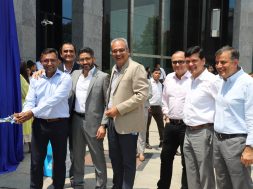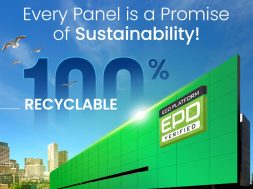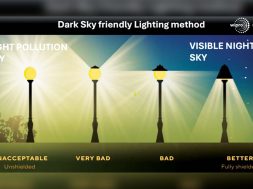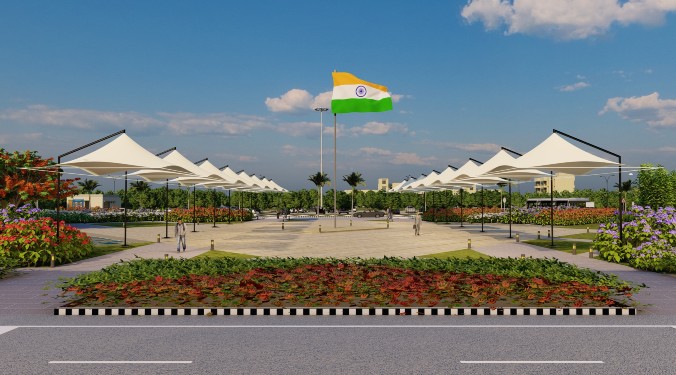“Sustainability in architecture provides a kind of balance between built and un-built environment by blurring lines between indoor and outdoor,” says Environmental Architect Alankrita Soni
Architecture is an indispensable ground for sustainable innovation and an interface among the environmental, economic and socio-cultural dimensions of sustainability in the built environment. In an interview with ACE Update, Ar. Alankrita Soni shares what is green architecture and how it benefits people, nation and environment.
Characteristics of green architectureGreen architecture is an approach to architectural design that promotes energy efficiency, renewable energy, water conservation, and resource conservation. Green architecture also considers environmental impacts and waste minimisation, creates healthy and comfortable spaces, reduces operation and maintenance costs, and addresses urban issues such as historical preservation, access to public transportation and amenities, community infrastructure systems, social inclusion and safety aspects. Green architecture considers the entire life cycle of the building and its components; as well as its social, economic and the environmental impact. Most important characteristics of green architecture are:• Climate responsive building design• Passive solar design• Energy and water efficiency • Energy-efficient lighting and appliances• Minimal harm to the natural habitat• Use of alternate power sources• Efficient use of space• Flexibility and adaptability• Healthier indoor spaces• Natural daylight and ventilation• Water efficient landscape design• Use of local, regional materials and technologies• Reducing-reusing-recycling materials.
Achieving sustainability in architectureArchitecture is an indispensable ground for sustainable innovation and an interface among the environmental, economic and socio-cultural dimensions of sustainability in the built environment. Sustainability in architecture provides a kind of balance between built and un-built environment by blurring lines between indoor and outdoor. For architecture to be truly sustainable, it is very important that architects and designers understand new global and environmental challenges ahead of them and design buildings which address those challenges with minimum mechanical intervention and reduced impact on the environment. Architecture that believes in using the power of natural forces like sun, wind, earth and water to create healthy, comfortable habitat for the people is truly sustainable. Today, the ecological crisis and dwindling resources present an urgent need to work out a responsible approach to create, construct and maintain buildings and infrastructure, while minimising negative impact on the environment. Sustainable architecture design plays an important role in addressing these issues.
The main objective of sustainable design is to reduce depletion of critical resources like energy, waste and raw material. Sustainable design also prevents environmental degradation and create livable, comfortable, safe and productive environment. Sustainable design is an opportunity to use resources efficiently while creating healthier buildings. It provides cost savings through improved human health and productivity, lower cost building operations, and resource efficiency and it moves us closer to a sustainable future. The idea of sustainability is to ensure that our actions and decisions today do not inhibit the opportunities of future generations. Sustainable architecture involves considering the entire life cycle of buildings, taking environmental quality, functional quality and future values into account.
Green roofs and IndiaGreen roof replaces traditional roofing with a living system of soil, compost and plants, creating natural green skin atop of a building. Green roofs have become a very important component of sustainable urban fabric. Nowadays green roofs and rooftop gardens can be seen as a part of urban fabric in most cities, benefiting the urban environment and its inhabitants. Green roofs have yet to catch up in a big way in India. Real benefits of green roof systems are still unexploited to its maximum potential, especially in warmer climates like India.
Green roofs consist of following layers:• Mother slab-concrete • Layer of waterproofing • Root barrier • Layer of drainage• Geo-textile filter• Lightweight and water retaining growing medium – soil• Plantation (grass, sedums, herbs etc.).
Benefits of green roofs are:• A well-designed green roof can provide greater energy savings compared to a cool roof or even an insulated roof due to better insulation properties• Green roofs can retain rainwater and also delays the runoff, reducing the pressure on storm-water drains• Through evapotranspiration, plantation on the roof can cool the city in the hot summer months and help reduce urban heat island effect.• Green roofs increase biodiversity; it can sustain a variety of plants and invertebrates and provides a habitat for various bird species.• Green roofs can be designed as small organic food gardens to promote urban agriculture. • By preventing large temperature variations, green roofs are less likely to crack and increase life span and durability of roof surfaces.• Plantation on green roofs helps capture airborne pollutants and atmospheric deposition as well as filters noxious gas and hence improves air quality.• Green roofs help visually in enhancing the cityscapes by providing aesthetically pleasing spaces. • Green roofs are known to reduce the electromagnetic radiation.• Green roofs have excellent noise attenuation as well as can reduce noise penetration.
Origin of greening roof surfaces stretch back into the distant past. Some experts believe that the custom of “planting hanging gardens on arches or roofs” evolved as early as 900 BC. The most famous example of green roof and vertical landscaping was created in the 600 BC by Assyrian king Nebuchadnezzar — the famous hanging gardens installed for over parts of the palace in Babylon. The gardens were considered as one of the seven wonders of the ancient world. Many well-known Byzantine and Indian miniature paintings also depict lush roof gardens and patios giving us a rough idea of how widespread the concept of greening the roof surfaces was in the past.
Exceptional efforts were made in past few decades by well-known architects and urban planners to promote roof gardens. In fact, architect Le Corbusier is considered as one of the first systematic roof greeners. Le Corbusier designed large number of spacious roof patios in most of his projects. Despite of fact that all these master architects recognised the potential and importance of using roof areas as green gardens, the idea did not take hold due to extra costs of construction associated with it and fear of serious structural damage that worked against its wider application. Today manufacturers and suppliers of green roof are creating a surge of innovative inspiring research encouraging development in green roof materials and technologies. New aspects related to green roofing like its climatic effects, energy- and water-saving benefits, environment-friendly techniques as well as solutions related to substrate, drainage and irrigation are being examined. It seems that people are finally realising the opportunities and benefits offered by green roofing systems.
Nowadays we see growing number of people who appreciate the ecological and economic value of greening roof surfaces and the whole idea of bringing nature back in the built environment. Green roof surfaces not only visually improve the cityscape but also improve the quality of life by providing cleaner and greener spaces in the urban environment, positively impacting the human health and psychology. Greening roof surfaces has a long tradition and will continue to evolve. Greening roof surfaces in our green-starved city scrapes is the most appropriate way of replacing lost nature from our modern day concrete jungles.
LEED doesn’t always guarantee energy efficiency Internationally, voluntary building rating systems like LEED have been instrumental in raising awareness, popularising green design, and improving energy and water efficiency in buildings. LEED is a tool for measuring and rating a building’s environmental performance. Its rating systems have a predefined set of criteria, and there are points for each one of these criteria. The projects are required to fulfil the defined criteria and achieve a certain number of points to be green rated. Depending on the number of credits achieved, project may earn a rating and certification at one of four levels (certified, silver, gold, or platinum).
A building is assessed based on its performance over its entire life cycle — inception through operation. The main objective of the rating systems is to help design green buildings and evaluate the “greenness” of new and existing buildings. The rating systems follows best practices along with national as well as international codes that are applicable to achieve the intent of sustainable green development. It is important to understand that LEED rating system emphasises on various aspects of green development and is not an exclusive building energy rating system. LEED rating system addresses various green building aspects, including energy and water efficiency, indoor air quality and holistic design. It encourages life-cycle analysis of development to help developers make an informed choice of construction process, material selection and technology application as well as achieve maximum efficiency in design.
Regarding energy efficiency, there are some disadvantages too. As LEED is a point-based rating system, it doesn’t always guarantee energy efficiency. All these rating systems, including LEED, are in their adolescent stage and improving day by day. As an environmental architect, Ar. Soni believes it is a must to acknowledge that all these rating systems have been really successful in setting targets for raising awareness about sustainable architecture as well as raising the standards of building design and construction. _____________________________________________Green roof surfaces not only visually improve the cityscape but also improve the quality of life by providing cleaner and greener spaces in the urban environment, positively impacting the human health and psychology.
Cookie Consent
We use cookies to personalize your experience. By continuing to visit this website you agree to our Terms & Conditions, Privacy Policy and Cookie Policy.









